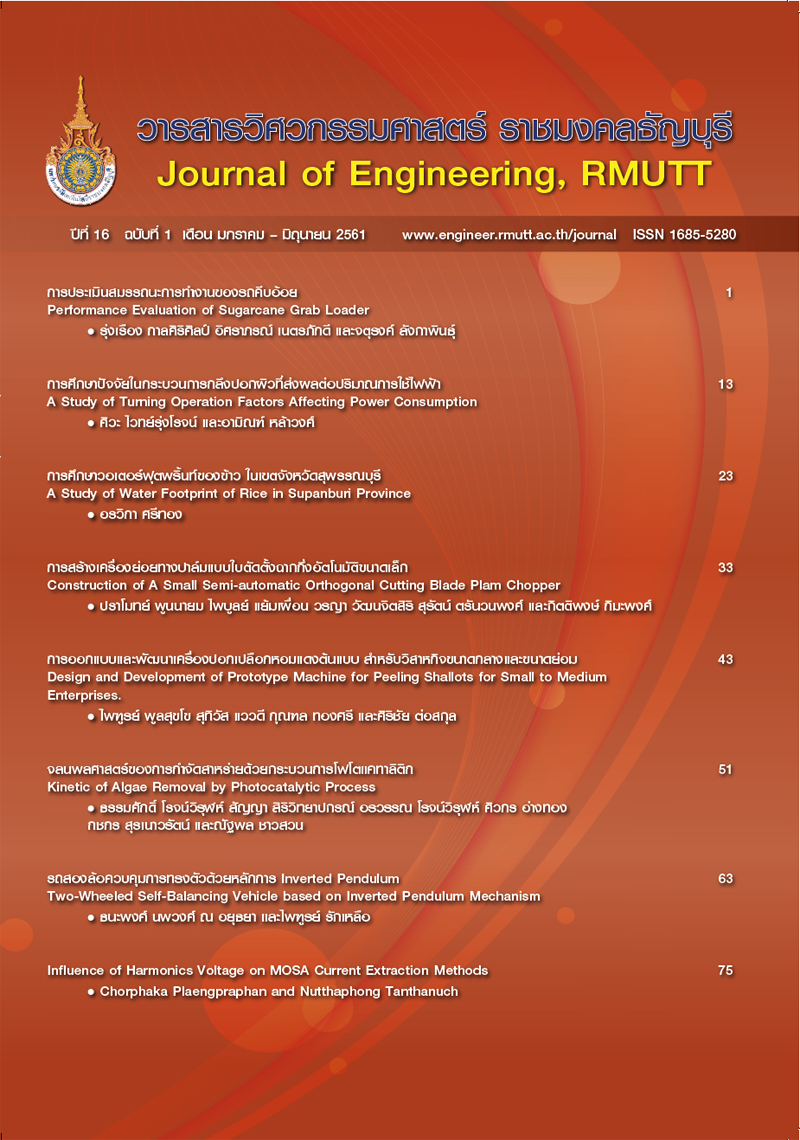A Study of Water Footprint of Rice in Supanburi Province
Main Article Content
Abstract
The objective of this research was to assess the water footprint of rice in Supanburi province in year 2016. In this research, the data was collected by the field research technique. Moreover, the WAPF software was used to assess the water footprint. The researcher collected the data which were distinguished into two types. Primary data was the filed collection from interviewing the 35 farmers. These data consisted of the area of rice production, rice data, and the amount of fertilizers. Secondly, the secondary data was recorded within the software. These were the volume of rainfall, Reference Crop Evapotranspiration (Eto), and Crop Coefficient (Kc). The results indicated that the blue water footprint (Wblue) was 1,246.48 m3/ton, the green water footprint (Wgreen) was 694.9 m3/ton, the grey water footprint (Wgrey) was 877.16 m3/ton, and the total water footprint of rice was 2,818.53 m3/ton. Furthermore, the yield of rice was average 0.8 ton/rai. From above results, the water footprint of rice in Supanburi province differed from other areas. Therefore, this research had presented the factors that made the differences and suggested the ways to reduce the water footprint of rice in Supanburi province as well.
Article Details
The manuscript, information, content, picture and so forth which were published on Frontiers in engineering innovation research has been a copyright of this journal only. There is not allow anyone or any organize to duplicate all content or some document for unethical publication.
References
University of Michigan., 2006. Human appropriation of the world's freshwater supply.
Hoekstra A. Y. and Chapagain A. K., 2007. “Water footprints of nations: Water use by people as a function of their consumption pattern," Water Resources Management. 21: 35-48.
Hoekstra A. Y. and Mekonnen M. M., 2012. "The water footprint of humanity," Proceedings of the National Academy of Sciences of the United States of America. 109 : 3232-3237.
สมาคมผู้ส่งออกข้าวไทย, 2559. "สถิติการส่งออกข้าวของไทย," ข่าวสมาคมผู้ส่งออกข้าวไทย. 2: 1.
สำนักงานเศรษฐกิจการเกษตร, 2558. สถิติการเกษตรของประเทศไทย ปี 2558. กรุงเทพ: สำนักงานเศรษฐกิจการเกษตร.
Chapagain A. K., Hoekstra A. Y., Savenije H. H. G., and Gautam R., 2006. "The water footprint of cotton consumption: An assessment of the impact of worldwide consumption of cotton products on the water resources in the cotton producing countries," Ecological Economics. 60: 186-203.
Leahy S., 2014. Your Water Footprint: The Shocking Facts about how Much Water We Use to Make Everyday Products: Firefly Books.
Mekonnen M. M. and Hoekstra A. Y., 2011 "The green, blue and grey water footprint of crops and derived crop products", Hydrology and Earth System Sciences. 15: 1577-1600.
สำนักงานเศรษฐกิจอุตสาหกรรม, 2557. ร่องรอยการใช้น้ำหรือวอเตอร์ฟุตพริ้นท์. [ออนไลน์] เข้าถึงได้จาก : http://fic.nfi.or.th/waterfootprint /index.php/component/content/article/79-studybasic/75-footprint23(31 พฤษภาคม 2560)
Hoekstra A. Y. and Chapagain A. K., 2008. Globalization of Water: Sharing the Planet's Freshwater Resources. Wiley.
Yin R. K., 2003. Case Study Research: Design and Methods. SAGE Publications.
Gosset W. S., 1908. "The Probable Error of a Mean," Biometrika. 6: 1-25.
Monteith J. L., 1965. "Evaporation and environment," Symp Soc Exp Biol. 19: 205-34.
ประกาศคณะกรรมการสิ่งแวดล้อมแห่งชาติฉบับที่ 8 (พ.ศ. 2537), 2537. กําหนดมาตรฐานคุณภาพน้ำในแหล่งน้ำผิวดิน. ราชกิจจานุเบกษา. เล่ม 111 ตอน16ง.
Hoekstra A. Y., Chapagain A., Martinez-Aldaya M., and Mekonnen M., 2011. The water footprint assessment manual; setting the global standard. Earthscan: London, UK.
Chapagain A. K. and Hoekstra A. Y., 2011. "The blue, green and grey water footprint of rice from production and consumption perspectives," Ecological Economics, 70 : 749-758.
ธีระวัฒน์ ธรรมนิยม, 2555. วอเตอร์ฟุตปริ้นท์ของข้าวในพื้นที่โครงการส่งน้ำและบำรุงรักษาโคกกระเทียม. ปริญญาวิศวกรรมศาสตรมหาบัณฑิต, มหาวิทยาลัยเกษตรศาสตร์, กรุงเทพมหานคร.
Chatpanyacharoen W., Hungspreug N., Anurugsa B., and Taweesuk S. 2015. "Water Footprint Evaluation of Oryza sativa L.Tha Wang Pha District, Nan Province", Thammasat International Journal of Science and Technology. 20: 21 – 28.


